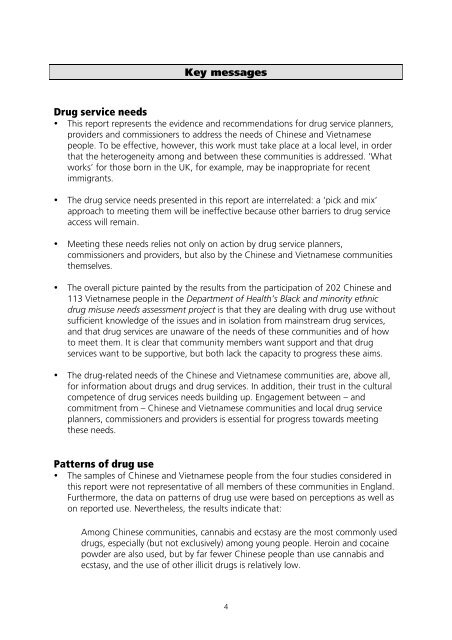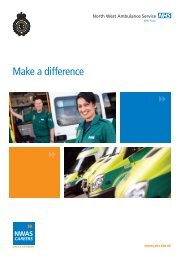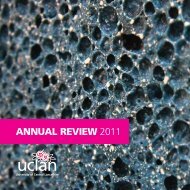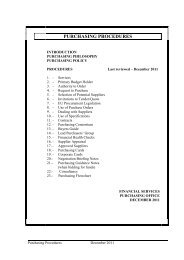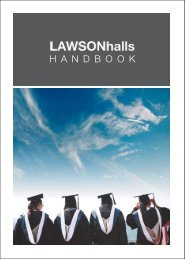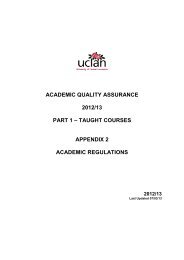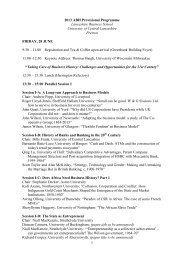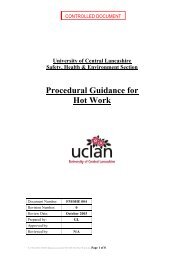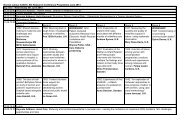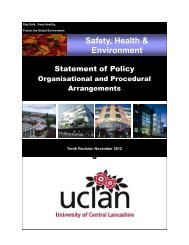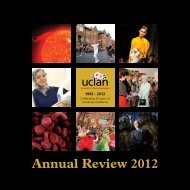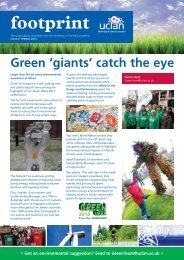5 Chinese Vietnamese Final - National Treatment Agency for ...
5 Chinese Vietnamese Final - National Treatment Agency for ...
5 Chinese Vietnamese Final - National Treatment Agency for ...
You also want an ePaper? Increase the reach of your titles
YUMPU automatically turns print PDFs into web optimized ePapers that Google loves.
Key messages<br />
Drug service needs<br />
• This report represents the evidence and recommendations <strong>for</strong> drug service planners,<br />
providers and commissioners to address the needs of <strong>Chinese</strong> and <strong>Vietnamese</strong><br />
people. To be effective, however, this work must take place at a local level, in order<br />
that the heterogeneity among and between these communities is addressed. ‘What<br />
works’ <strong>for</strong> those born in the UK, <strong>for</strong> example, may be inappropriate <strong>for</strong> recent<br />
immigrants.<br />
• The drug service needs presented in this report are interrelated: a ‘pick and mix’<br />
approach to meeting them will be ineffective because other barriers to drug service<br />
access will remain.<br />
• Meeting these needs relies not only on action by drug service planners,<br />
commissioners and providers, but also by the <strong>Chinese</strong> and <strong>Vietnamese</strong> communities<br />
themselves.<br />
• The overall picture painted by the results from the participation of 202 <strong>Chinese</strong> and<br />
113 <strong>Vietnamese</strong> people in the Department of Health’s Black and minority ethnic<br />
drug misuse needs assessment project is that they are dealing with drug use without<br />
sufficient knowledge of the issues and in isolation from mainstream drug services,<br />
and that drug services are unaware of the needs of these communities and of how<br />
to meet them. It is clear that community members want support and that drug<br />
services want to be supportive, but both lack the capacity to progress these aims.<br />
• The drug-related needs of the <strong>Chinese</strong> and <strong>Vietnamese</strong> communities are, above all,<br />
<strong>for</strong> in<strong>for</strong>mation about drugs and drug services. In addition, their trust in the cultural<br />
competence of drug services needs building up. Engagement between – and<br />
commitment from – <strong>Chinese</strong> and <strong>Vietnamese</strong> communities and local drug service<br />
planners, commissioners and providers is essential <strong>for</strong> progress towards meeting<br />
these needs.<br />
Patterns of drug use<br />
• The samples of <strong>Chinese</strong> and <strong>Vietnamese</strong> people from the four studies considered in<br />
this report were not representative of all members of these communities in England.<br />
Furthermore, the data on patterns of drug use were based on perceptions as well as<br />
on reported use. Nevertheless, the results indicate that:<br />
Among <strong>Chinese</strong> communities, cannabis and ecstasy are the most commonly used<br />
drugs, especially (but not exclusively) among young people. Heroin and cocaine<br />
powder are also used, but by far fewer <strong>Chinese</strong> people than use cannabis and<br />
ecstasy, and the use of other illicit drugs is relatively low.<br />
4


